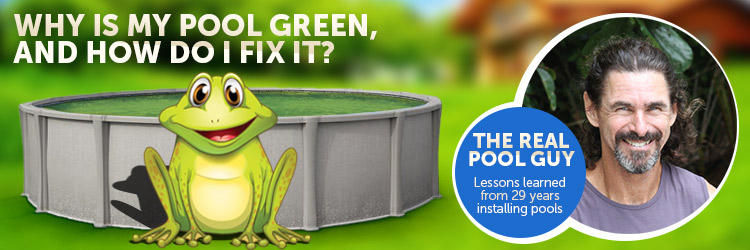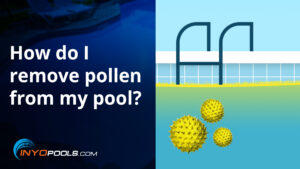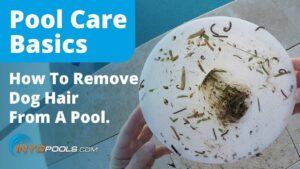Your above ground pool turned green. It’s bound to happen at least once or twice. There’s always a good reason. You got busy or went on vacation. The pump stopped working or the timer broke and you didn’t notice. Maybe you had a big pool party with a bunch of people who couldn’t control their bladders? Or, maybe there was a week of bad weather? Whatever the reason, the pool is now green. So, what do we do to get it back to that beautiful clear and healthy state? Let me help.
Why Does a Pool Turn Green Anyway?
The reason is algae. There are millions and billions and trillions of algae. When a swimming pool’s water is clear and you can see the bottom of the pool perfectly, there is hardly any life in the water. When a pool goes untreated or if the water doesn’t move around and doesn’t get filtered, it becomes an environment that’s conducive to the growth of living things.

A pool that has favorable conditions for living things will start out with a little bit of algae. These algae are like pioneers with lots of land to share. They can reproduce in great numbers. Their offspring can breed too, so before you know it the pool gets a little cloudy. This cloudiness is an indication that the water is populated with living things and that this is becoming visible to our naked eyes. At this point the cloudy pool’s population is similar to the state of Florida’s population. A couple more days of growth and the pool starts to turn a light green color.
When the pool is light green, you’ve gone from a town of pool algae to an entire city of algae. Another couple of days and the light green pool becomes darker. Now you’ve got New York City. Super dark green and your pool turns into NYC, Tokyo, Delhi, Mexico City, and Shanghai all stacked together. So, the greener your pool turns, the bigger the population of living things becomes.
Nerdy facts, like why are algae green, I’ll leave to Bill Nye the Science Guy to answer. It’s only important to know that you’re dealing with something that must be killed and disposed of in order for you to get your beautiful and healthy pool back.
[dyna
It’s All About Shocking With Chlorine
Now you know your pool is green because it is overpopulated with algae and that the algae must be killed and eliminated. How do you do that? The short answer is to use a lot of chlorine in a short period of time. Or, in other words, shock it. Random pool guy definition: The term “shock” means introducing a large amount of chlorine to a body of water in a short period of time. Chlorine is the best because it can kill the algae and it does a great job of getting rid of it.
Next Question: How Much Chlorine Do You Need?The greener the pool, the more algae you have. The more algae you have, the more chlorine is needed. It doesn’t take too much to kill all the algae, but it’ll take quite a bit of the chemical to get the dead algae out of the water. That’s really all I or anyone else can say about how much chlorine it’s going to take to clear your pool, because

no one knows just how much algae each green pool has.
The greener the pool, the more algae you have. The more algae you have, the more chlorine is needed. It doesn’t take too much to kill all the algae, but it’ll take quite a bit of the chemical to get the dead algae out of the water. That’s really all I or anyone else can say about how much chlorine it’s going to take to clear your pool, because no one knows just how much algae each green pool has.
I could explain the amount of chlorine it takes per gallon of pool water to raise it so many parts per million blah, blah, blah… I could also explain the make-up of chlorine and how it works best at certain pH levels to do different things (blah, blah). Surely if you are writing a paper on swimming pool water chemistry, these fun facts would be needed. If you just want to get your pool’s water clear again, then follow these steps:
The Non-Chemist Guide to Clearing a Green Swimming Pool
- Make sure the pump and filter are working properly.
Check the water pressure that is going back to the pool and ensure it is strong. Clean the filter. Note: If you have a sand filter, I’m so sorry. This is going to take longer to get your pool back to clear water.
- Test the water.
Hopefully your chlorine level is at zero. If it is high, don’t add any more chlorine until the level is zero. This is important so just take my word for it and wait. Make sure the pH is normal or a little low.
- Add liquid chlorine.
Don’t buy your chorine at Walmart or Home Depot. It’s old and overpriced. Go to a pool store to buy chlorine (get the yellow reusable 2.5 gallon jugs). Add only one 3” tablet to the chlorinator or floater.3(a) If you have a 24’ round above ground pool (or any pool larger than this size), add two of the 2.5 gallon jugs of chlorine.
3(b) If your pool is a 21’ round above ground pool (or any pool smaller than this size), add one 2.5 gallon jug of chlorine. - Run the pool pump for 12 hours a day.
Running the pump/filter for 12 hours will allow the dead algae to settle on the bottom of the pool so you can then complete step five more effectively.
- Vacuum the pool to waste.
Do this after the pump has been off for at least a few hours. Vacuuming to waste will send all the dead algae completely out of the pool and into the yard which is ideal. If you can’t “vacuum to waste”, vacuum it anyway as it will still help (just not nearly as much).
- Clean the filter.
- Repeat steps 2 to step 6 every day.
You will have to repeat these steps at first. What’s most important here is that you wait until the chlorine level goes back down to zero or almost zero before adding more. As the days go by, there will be less and less algae to get rid of so you won’t have to complete these steps as often.
If you have any questions on your above ground pool then we would be happy to help, feel free to give us a call at 1-877-372-6038 or email us at upload@inyopools.com If you liked this article then make sure to sign up for Blog and get our Free 128 Page Pool Care Guide.












Leave a Reply